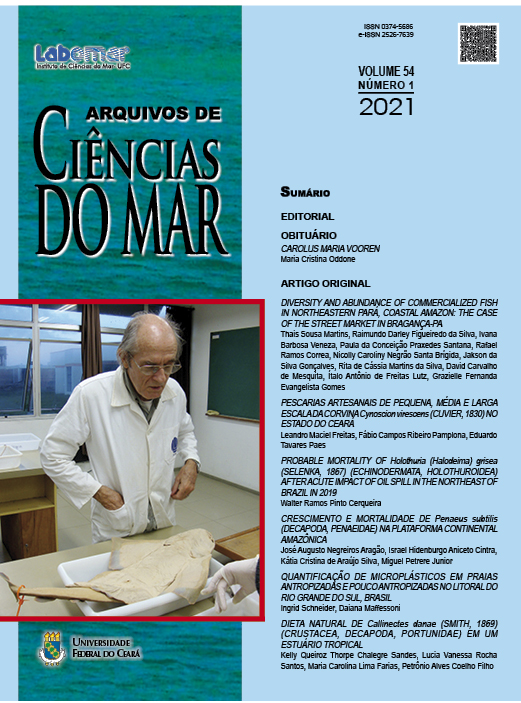THE USE OF ACOUSTIC TELEMETRY TO MONITOR FISH SPECIES IN MARINE PROTECTED AREAS: A SYSTEMATIC REVIEW WITH NOTES ON BRAZILIAN PERSPECTIVES
Uso da telemetria acústica no monitoramento de peixes em áreas marinhas protegidas: uma revisão sistemática com notas sobre as perspectivas brasileiras
DOI:
https://doi.org/10.32360/acmar.v54i1.61296Resumen
Inferring pathways used by organisms within ecosystems is essential to the design, management and evaluation of Marine Protected Areas (MPAs). This study aimed to present a systematic review on the literature regarding the use of acoustic telemetry to monitor marine fish movement and its application on MPAs. Searches were conducted on electronic databases. The first studies using telemetry on marine fish date back to the 60’s, while application on MPAs only appeared 30 years later. However, over the last
decade, studies in MPAs accounted for 20% of the overall acoustic telemetry publications on marine fish species. Recent technological development has had an important impact on those results. The number of studies inside MPAs followed the number of general studies and coverage areas of MPAs declared around the world, although frequency of studies did not match MPA coverage in some countries. Developed countries scored more studies, probably due to the relative high cost of acoustic telemetry. Studies in Brazilian MPAs are scarce, with only one study available on elasmobranchs. Brazil has recently increased its
MPA coverage to 26%, so it is expected to increase the need for MPA effectiveness studies. Brazilian participation on global tracking networks may help filling this gap.
Keywords: PRISMA statement, fish movement, remote monitoring, MPA effectiveness, tracking networks
Descargas
Publicado
Número
Sección
Licencia
Derechos de autor 2021 Arquivos de Ciências do Mar

Esta obra está bajo una licencia internacional Creative Commons Atribución 4.0.
1. Proposta de Política para Periódicos de Acesso Livre
Autores que publicam nesta revista concordam com os seguintes termos:
- Autores mantém os direitos autorais e concedem à revista o direito de primeira publicação, com o trabalho simultaneamente licenciado sob a Licença Creative Commons Attribution que permite o compartilhamento do trabalho com reconhecimento da autoria e publicação inicial nesta revista.
- Autores têm autorização para assumir contratos adicionais separadamente, para distribuição não-exclusiva da versão do trabalho publicada nesta revista (ex.: publicar em repositório institucional ou como capítulo de livro), com reconhecimento de autoria e publicação inicial nesta revista.
- Autores têm permissão e são estimulados a publicar e distribuir seu trabalho online (ex.: em repositórios institucionais ou na sua página pessoal) a qualquer ponto antes ou durante o processo editorial, já que isso pode gerar alterações produtivas, bem como aumentar o impacto e a citação do trabalho publicado (Veja O Efeito do Acesso Livre).

